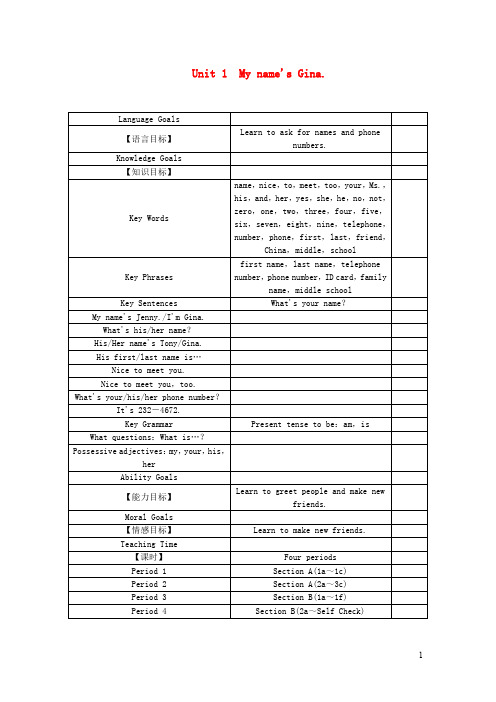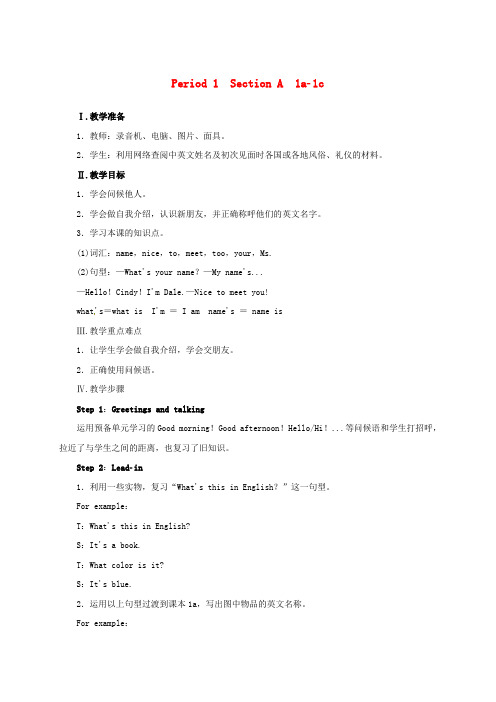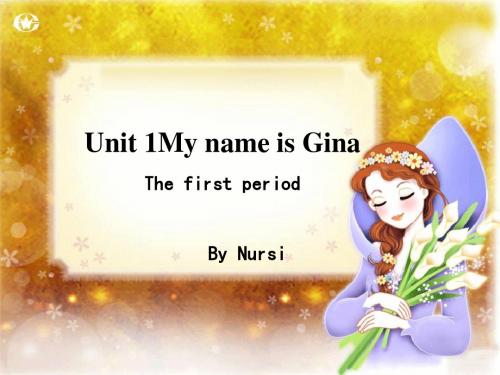七年级英语新目标上Unit 1 My name’s Gina section B (1)
- 格式:ppt
- 大小:1.11 MB
- 文档页数:9


人教新目标版英语七上Unit 1《My name’s Gina》Period 1(Section A 1a-1c)教案一. 教材分析人教新目标版英语七上Unit 1《My name’s Gina》Period 1(Section A 1a-1c)主要介绍了个人信息的介绍,包括姓名、年龄、年级、学校和喜欢的科目。
本节课主要通过听力、口语和阅读的方式,让学生掌握基本的个人信息介绍的表达方式,并能够运用到实际生活中。
二. 学情分析学生在进入七年级后,已经具备了一定的英语基础,能够进行简单的英语交流。
但是对于一些个人信息的介绍,可能还不太熟悉,需要通过本节课的学习来进一步掌握。
此外,学生可能对听力部分有一定的困难,需要通过教师的引导和帮助来提高听力水平。
三. 教学目标1.能够正确地介绍自己的姓名、年龄、年级、学校和喜欢的科目。
2.能够听懂并能够正确地回答关于个人信息的问题。
3.能够通过阅读和听力,获取关于他人个人信息的信息。
四. 教学重难点1.重点:能够正确地介绍自己的个人信息。
2.难点:能够听懂并能够正确地回答关于个人信息的问题。
五. 教学方法采用任务型教学法,通过听力、口语和阅读的方式,让学生在实际任务中掌握个人信息介绍的表达方式。
同时,运用分组合作和角色扮演等教学方法,提高学生的参与度和积极性。
六. 教学准备1.教学PPT2.录音机和录音带3.相关图片和卡片七. 教学过程1.导入(5分钟)利用图片和卡片,引导学生进行关于个人信息的问答,激发学生的兴趣。
例如:教师出示一张图片,问学生:“What’s her name? How old is she?”等。
2.呈现(5分钟)教师播放录音,让学生听懂并回答关于个人信息的问题。
录音内容为:不同人介绍自己的姓名、年龄、年级、学校和喜欢的科目。
例如:A: My name’s Gina. I’m twelve. I’m in Grade Seven. I like math. B: My name’s Tom. I’m eleven. I’m in Grade Six. I like Chinese. 等。

Period 2 Section A 2a-3cⅠ.教学准备1.教师名人图片、师生照片、录音机、课件等。
2.学生收集关于用英语介绍他人的资料。
Ⅱ.教学目标1.使学生继续掌握如何用英语介绍他人。
2.掌握形容词性物主代词及be动词的用法。
3.学习本课的知识点。
(1)词汇:his,and,her,yes,she,he,no,not(2)句型:—What's his/her name?—His/Her name is...He is.../She is...—Ishe/she...?—Yes,he/she is.No,he/sheisn't.—Areyou...?—Yes,Iam./No,I'm not.4.进一步促进学生之间的相互了解,使学生在轻松、愉快的学习氛围中熟识新伙伴,增进友谊。
Ⅲ.教学重点形容词性物主代词及be动词的用法。
Ⅳ.教学难点形容词性物主代词及be动词的用法。
Ⅴ.教学步骤Step 1:Greetings and talking运用以下句型复习导入—What's your name?—My name is...—I'm...Nice to meet you!—Nice to meet you,too.建议1:请两三组学生表演完上述对话后,老师指着其中一名学生询问其他学生,“What's his/her name?”并板书,引导学生回答“His/Her name's...”For example:T:What's his name?Ss:His name's...T:Yes,his name's...We can also say:He is...建议2:请两三组学生表演完对话后,播放一段名人间相互问候的视频片段,再引入本课句型:—What's his/her name?—His/Her name's...For example:Play a VCR of Jay Chou.“Hello,I'm Jay Chou.Nice to meet you.”T:What's his name?Ss:He is Jay Chou.T:Do you like him?Ss:Yes.T:Let's say hello to him,OK?Ss:Hello,Jay Chou.Nice to meet you.Step 2:Learn and present the new drills建议1:出示一些人物照片,让学生运用句型介绍。

Unit 1 My name's Gina.Period 1 Section A (1a~1c)Teaching important points【教学重点】1.Key words & phrases:name,nice,to,meet,too,your,Ms.2.Key sentences:What's your name?My name's Gina.Nice to meet you.Teaching difficult points【教学难点】How to listen to and ask for names.Teaching aids【教具】a tape player,some cards and real thingsTeaching procedures and ways【教学过程及方法】★Step Ⅰ Revision and lead-in复习导入Free talk:Show the students a few real things and ask them to ask and answer about the things in pairs.eg:A:What's this in English?B:It's a ruler.A:What color is it?B:It's yellow.A:Spell “yellow”,please!…Lead-in:Greet students and make a self-introduction.T:Good morning/afternoon,boys and girls!It's very nice to meet you here.I'm Yuan Li.You can call me Miss Yuan,OK?Well,may I know your names?S1:My name is Song Tao.Nice to see you,Miss Yuan.S2:I'm Han Ting.Nice to meet you.S3:And I'm Liu Fen.Glad to meet you.T:Now you see.We are going to learn to greet people and ask for names today.★Step Ⅱ Self-studying and guiding自学指导Self-study guide 1:Self-study the new words:name,nice,to,meet,too,your,Ms.You can listen to the tapes to help you pronounce them correctly or ask others for help.Self-study guide 2:Self-study 1a on Page 1 and try to understand it.Questions for thinking:I'm Cindy.=________ ________ ________ Cindy.Answer the question:—What's your name?—________.The teacher walks around the classroom to watch and help the students study while the students are self-studying.Encourage students to find out their problems in self -studying both in pronunciation and understanding.Time for questions:Discuss the difficulties that most students have and explain the language points that most students can't understand.★Step Ⅲ Check up检查核对Check up 1:Words teaching:Ask a few students to read the new words and help them correct the mistakes in pronunciation if necessary.Check up 2:Greet a few students and see if they can respond correctly.T:Good morning.My name is Yuan Li.Nice to meet you.S1:My n ame is…Nice to meet you,too.…Check up 3:Check the answers to the exercises above.T:So in order to introduce yourself,we can use:My name is…or I am…★Step Ⅳ Cooperative inquiry合作探究1.Listening (1b)Listen and number the conversations[1-3].Play the recording.Then check the answers.2.Practice in pairsAsk students to practice the conversations above with their partners and make their own conversations.3.Chain work:Ask students to work in groups.The first student asks the second student for his or her name.The second student answers the question and goes on to ask the third student for his or her name…A:Hello,I'm Gina.What's your name?B:My name is Bob.Nice to meet you.A:Nice to meet you,too.B:Hi,I am Bob.What's your name?C:My name is…★Step Ⅴ Practi ce练习用所给单词的适当形式填空。

Period 1 Section A 1a1cⅠ.教学准备1.教师:录音机、电脑、图片、面具。
2.学生:利用网络查阅中英文姓名及初次见面时各国或各地风俗、礼仪的材料。
Ⅱ.教学目标1.学会问候他人。
2.学会做自我介绍,认识新朋友,并正确称呼他们的英文名字。
3.学习本课的知识点。
(1)词汇:name,nice,to,meet,too,your,Ms.(2)句型:—What's your name?—My name's...—Hello!Cindy!I'm Dale.—Nice to meet you!what's=what is I'm = I am name's = name isⅢ.教学重点难点1.让学生学会做自我介绍,学会交朋友。
2.正确使用问候语。
Ⅳ.教学步骤Step 1:Greetings and talking运用预备单元学习的Good morning!Good afternoon!Hello/Hi!...等问候语和学生打招呼,拉近了与学生之间的距离,也复习了旧知识。
Step 2:Leadin1.利用一些实物,复习“What's this in English?”这一句型。
For example:T:What's this in English?S:It's a book.T:What color is it?S:It's blue.2.运用以上句型过渡到课本1a,写出图中物品的英文名称。
For example:T:Look at the picture.What's this in English?S:It's a map.T:How many new words can you find?Discuss in groups.将学生分为四组,采取小组竞赛制,每组选择一名学生将单词写在黑板上,比一比哪一组写得多。

人教新目标版英语七上Unit 1《My name’s Gina》Period 3(Section B 1a-1f)教学设计一. 教材分析人教新目标版英语七上Unit 1《My name’s Gina》Period 3(Section B 1a-1f)主要包括两部分内容:1a的听力练习和1f的口语交际。
通过上一节课的学习,学生已经掌握了基本的自我介绍和询问他人信息的表达方式。
本节课将进一步巩固这些表达方式,并学习如何用英语描述他人的外貌和兴趣爱好。
二. 学情分析七年级的学生已经具备了一定的英语基础,能够进行简单的日常交流。
但部分学生对英语的学习兴趣不高,听力能力和口语表达能力有待提高。
针对这一情况,教师应注重激发学生的学习兴趣,创设真实语境,让学生在实践中提高英语运用能力。
三. 教学目标1.知识目标:学生能够听懂、会说、会读以下单词和短语:classmate, friend, hr, eye, tall, short, teacher, doctor等。
学生能够运用所学知识进行简单的自我介绍和询问他人信息。
2.能力目标:学生能够提高听力能力,通过听力练习获取相关信息。
学生能够在真实语境中运用所学知识进行口语交流。
3.情感目标:学生能够积极参与课堂活动,提高学习英语的兴趣。
学生能够学会尊重他人,关爱他人。
四. 教学重难点学生能够熟练运用所学单词和短语进行自我介绍和询问他人信息。
学生能够听懂、说出一般现在时的疑问句和回答。
学生能够正确运用一般现在时描述他人的外貌和兴趣爱好。
学生能够听懂、会说、会读一般现在时的疑问句和回答。
五. 教学方法1.任务型教学法:通过设定各种真实任务,让学生在完成任务的过程中运用所学知识。
2.情境教学法:创设真实语境,让学生在实践中提高英语运用能力。
3.交际法:注重学生之间的互动,提高学生的口语表达能力。
六. 教学准备1.准备单词和短语的卡片。
2.准备听力材料和练习题。
3.准备口语交际的场景和角色扮演道具。
Unit 1 My name's Ginarevision 1. Play the tape, enjoy the ABC song or Hello song, get the Ss to sing together.2. Warm greetings to the studentsT: Hello! / Hi! S: Hello! / Hi!T: You are very beautiful/cool/… S: Thank you.3. Show some objects to the Ss. Ask "What's this in English?" Ge t Ss answer in English.4. Have Ss look at the picture on Page 1, and write down the name of things in the picture. ThenGet the Ss to sing together.Teacher setsan example forthestudents聚焦3check the answers. Ⅱ. Presentation1. T: Hello! My name is Lily. What’s your name? 3S: My name is Tom. T: It’s a good / nice name. I like your name.2. T: Hi! I’m Lily. / My name’s Lily. S: Hi! Lily. I’m Alan.T: Nice to meet you! S: Nice to meet you! 3.4. T: (Show a photo of Liu Dehua) Is he Liu Xiang?Help Ss answer: No, he isn't. He's Liu Dehua.Then (Show aT: (Ask a boystand up) What’s hisname?Ss: His name is … (Repeat withanother boy.) T: (Ask a girlstand up) What’s hername?5 6photo of Liu Xiang) Is he Liu Xiang?Help Ss answer: Yes, he is. (Pointto some students in the class.) Is he/she…?Let some Ss answer the questions. 5.Writethe expressions on the blackbo ard. Tell the Ss to pay attention to:what ’s =what is I ’m =I am name ’s =name isⅢ. Game (Choose an English name.)T: Look here. I have a lot of small gifts Ss: Her name is …(Repeat with another girl.)Point out the boxeswherestudents will write a number4 3for you. Come here and touch. Try to say them in English, I’ll give you the gift and let you choose an English name first.S: Yeah.S1: (获得英文名后) My name’s…/ I’m…S (全班): Nice to meet you!S1: Nice to meet you!Ⅳ. ListeningT: Now let’s listen to the tape, find out the right conversation, and numberthem1-3. (conversations.)Dialogue 1: A: Good morning! I’m for eachconversation.Play therecording forthe firsttime, Ss onlylisten. Thenplay a secondtime, Ssnumber theAsk the Ss topractice theconversations45Cindy.B: Hello, Ci ndy. I’m Dale. A: Nice to meet you! Dialogue 2: A: What’s your name? B: Alan. A: Hello, Alan. I’m Ms Brown. Dialogue 3: A: Hi. My name’s Gina.B: I’m Jenny. Nice to meet you!A: Nice to meet you, too. Ⅴ. Pair work1. Encourage the Ss to leave their seats, move around and greet other classmates. in 1b with apartner. Thenuse their ownnames topracticeinstead of thenames given.T: Now. Looka t the namesin the box.Let's read thenamestogether.322 . Get some pairs to come to the front of the class and act out the dialogue after they have practiced several times.Ⅵ. Listening 1. Work on 2a;T: Now, look at the pictures on P2, listen to the four conversations. Just listen.Then, listen to the recording again, andnumberthe pictures. The first one has down for you.Check the answers. 2. Work on 2b; T: Now. Look atSs read the namesaloudtogether.T: Now listen again. Circle the names you hear.Playtherecording. Students listenand circle the namesthey hear.Then check theanswers.3the names in the box. Let's read the names together.Ss read the names aloud together.T: Now listen again. Circle the names you hear.Play the recording. Students listen and circle the names they hear. Then check the answers. Ⅶ. Pair work1. Suppose you are new students in No. 1 Middle School. You are from different countries. You meet for the first time. Make up a dialogue in pairs. Makeamodel2. T: (Point to the firstboy)What'shis name?Ss: His name is Mike.T: (Point to the firstgirl) What’sher name?Ss: Her name is Jane.Then ask the second the boy and the thirdgirl's names.dialogu e with a student. Other studentsshould listen carefully. T:Hello!What’s your name? S1: My name’s… T: I’m… S1: Nic e to meet you!T: What’s his name?S1: His name is… T: And what’s her name?S1: Her name is… 2. Let all the students work in pairs. Practice the dialogue. Then ask some pairs to act outtheirdialogues.(Helen, Linda)2. What’s your/his/her name?My/His/Her nameis…3. —Is he/she…?—Yes, he/she is. No, he/she isn't.Grammar:1. 缩写形式:What’s = What is I’m=I amname’s=name is2. 形容词性物主代词:your, his, her应注重口语交际练习和书写。
亲爱的同学:这份试卷将再次记录你的自信、沉着、智慧和收获,我们一直投给你信任的目光……学习资料专题Unit 1 My name’s GinaStep 1Warming upSing along with a song, 26个字母歌Step 2Preparing and GuidePart 1 Knowledge revisionT: Show some things on the desk, and let Ss say them one by one and check their answers.Ss: window, book, schoolbag, ruler, map, door, cup, baseball…Part 2 New course guideT: Well, in this class, we'll learn how to introduce yourself.Step 3Research CooperationInteraction research1. Pair work.T: Look at the picture in 1a. There are many things. You can find them out as many as possible. You can make a match with your partner. Well, there are some names, can you see?Ss: Yes.T: Can you read the names? OK, let's listen and find out who they are.2. Listening practice.(Give Ss 2 minutes to read the conversations before listening and then play the recording for the first time. Ss listen and finish 1b.)Listen again and get the Ss to put the three conversations in order…T: Now, please tell me your answer.Ss: 2,1,3T: OK, good! Now, please listen again and try to follow each sentence.[设计意图:通过不同梯度的练习,让学生逐渐掌握听力的技巧,逐步提高听说能力。